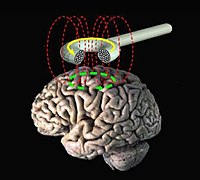
Photo from wikipedia
Several forms of transcranial brain stimulation have been developed to produce after-effects on the cortical excitability outlasting the stimulation itself for a period of time in the conscious human’s brain.… Click to show full abstract
Several forms of transcranial brain stimulation have been developed to produce after-effects on the cortical excitability outlasting the stimulation itself for a period of time in the conscious human’s brain. Several lines of evidence suggest that transcranial brain stimulation change the excitability of the neuronal circuits through plasticity-like mechanisms. Such plasticity that is induced by transcranial brain stimulation in the motor cortex can be modulated by voluntary contraction that has no plasticity effect on its own. Not only the timing, but also the pattern of contraction is known to be crucial in determining the amount and direction of plasticity happening around the movement. Moreover, brief tonic voluntary contraction could modify plasticity induced in the motor cortex controlling the antagonist muscle, indicating not only the activity in the targeting area, but also that in a remote area connecting to this area, could modulate the effect of transcranial brain stimulation. Similar interactions have been also found in the visual cortex. The interaction between physical activities and the effects of transcranial brain stimulation may be explained by metaplasticity and reversal of plasticity, i.e. depotentiation and de-depression, and suggests that the physiological activity and synapses work synergistically in learning. The physiological activity during practice may fine tune the amount and direction of plasticity to improve learning. However, when a specific kind of plasticity is aimed to induce, the physiological activity should be well controlled to maintain a predictable result. In summary, the modulation effect of physical activities on the after-effect of transcranial brain stimulation has opened a door to further understand physiological mechanism of learning. On the other hand, by learning from such influence on the after-effect, the state of neuronal activity should be carefully controlled for a stable and predictable effect of transcranial brain stimulation.
Journal Title: Clinical Neurophysiology
Year Published: 2017
Link to full text (if available)
Share on Social Media: Sign Up to like & get
recommendations!